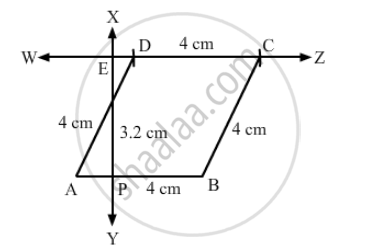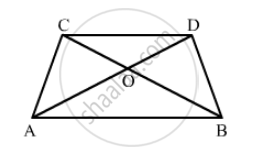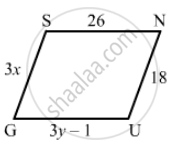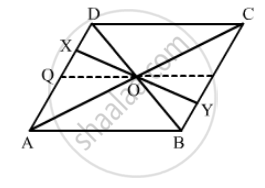Advertisements
Advertisements
प्रश्न
One side of a rhombus is of length 4 cm and the length of an altitude is 3.2 cm. Draw the rhombus.
उत्तर

1. Draw a line segment AB of 4 cm.
2. Draw a perpendicular XY on AB, which intersects AB at P.
3. With P as centre, cut PE at 3.2 cm.
4. Draw a line WZ that passes through E. This line should be parallel to AB.
5. With A as centre, draw an arc of radius 4 cm that cuts WZ at D.
6. With D as centre and radius 4 cm, cut line DZ. Label it as point C.
4. Join AD and CB.
APPEARS IN
संबंधित प्रश्न
Given below is a parallelogram ABCD. Complete each statement along with the definition or property used.
(i) AD =
(ii) ∠DCB =
(iii) OC =
(iv) ∠DAB + ∠CDA =

In the following figure GUNS and RUNS are parallelogram. Find x and y.

In a parallelogram ABCD, ∠D = 135°, determine the measure of ∠A and ∠B.
Diagonals of parallelogram ABCD intersect at O as shown in the following fegure. XY contains O, and X, Y are points on opposite sides of the parallelogram. Give reasons for each of the following:
(i) OB = OD
(ii) ∠OBY = ∠ODX
(iii) ∠BOY = ∠DOX
(iv) ∆BOY ≅ ∆DOX
Now, state if XY is bisected at O.

In a parallelogram ABCD, AB = 10 cm, AD = 6 cm. The bisector of ∠A meets DC in E, AEand BC produced meet at F. Find te length CF.
Fill in the blank, inthe following, so as to make the statement true:
A rhombus has all its sides of ...... length.
Fill in the blank, in each of the following, so as to make the statement true:
If the diagonals of a parallelogram bisect each other at right angles, then it is a ......
The diagonals of a quadrilateral are perpendicular to each other. Is such a quadrilateral always a rhombus? If your answer is 'No', draw a figure to justify your answer.
Show that each diagonal of a rhombus bisects the angle through which it passes.
Which of the following statement is true for a rectangle?
Its diagonals are equal and bisect each other.
